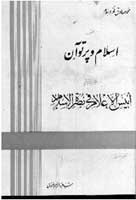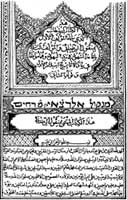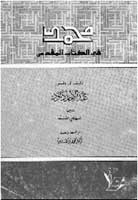|
Two attempts have been made
to study this prophecy and apply it to the ministry of our Prophet,
Mohammad.
The first attempt
This
attempt was initiated by Abdul Salaam (1), a former Jewish scholar. His
translation of the text is as follows:
“No ruler, of Judah, will
relinquish power, nor a lawgiver from between his feet, until he to whom
it belongs comes, and unto him shall the gathering of the people be.”
Abdul
Salaam said in his book, (Ar-Risalah
al-Hadiya ) the Guiding Epistle:
“It is evident from this
verse that it purports that our master, Mohammad, would come after the
completion of the ministries, of both Moses and Jesus, for what "the
ruler" refers to is Moses; this is borne by fact that after Jacob, no
prophet with the Law was sent till the time of Moses, apart from Moses
himself.”
"The
lawgiver" is Jesus because after Moses, till the time of Jesus, no
prophet with the Law was sent, apart from Mohammad.
It,
therefore, follows that what is gleaned from Jacob's assertion "in the
last days" is the reference to our Prophet, Mohammad. The reason being
that, at the end of the ministry of "the ruler" and the one who came
after him "the lawgiver", no one had been sent, save our Prophet,
Mohammad.
This
conclusion is also supported by the phrase "until he to whom it
belongs comes”, i.e. the one who would rule, as is evident from the
context of the verse and its implications.
As for
the phrase "unto him shall the gathering of the people be", it is
yet another clear proof that it is Mohammad, for no nations gathered
together for any one except him.
The
reason why the Book of Psalms did not mention it is because it does not
contain injunctions and that David, the Prophet, was a follower of
Moses. Jacob was the one who came with the injunctions (2).
The
proponents of this trend of understanding the text are:
1.
Mohammad Ridha, an Iranian Jewish scholar, who converted to Shia Islam
in 1237 H.L. (1822 CE). (3)
2.
Scholar Rahmatullah al-Kiranawi, the author of "Idhharul Haq -
Manifestation of the Truth", written in 1280 H.L. (??? CE). (4)
3.
Mohammad Sadiq Fakhrul Islam, an Iranian Christian cleric who embraced
Shia Islam at the beginning of the 14th Century H.L. (??? CE). (5)
This
attempt faces an uphill struggle, in that Moses was not among the
offspring of Judah, son of Jacob. Rather, he was among the children of
Levi, son of Jacob. Thus, considering him among the progeny of Judah is
an aberration, to say the least.
|
كتاب
أنيس الأعلام في نصرة
|

|
|
|
الصفحة
الأولى من كتاب
المنقول الرضائي
|

|
|
The second attempt
This
was made (6) by Professor Abdul Ahad Dawud.(7).
His
translation of the text goes like this:
“The
Sceptre shall not depart from Judah, and the lawgiver from between his
feet, until the coming of Shiloh; and to him belongeth the obedience of people.”
The
main thrust of his attempt was the study of the onnotations of the word
( )"Shiloh"
that is found in the original Hebrew edition. He has though added to it
the opinions espoused by the proponents of the first trend in reading
the text, concluding that it applies to Mohammad. )"Shiloh"
that is found in the original Hebrew edition. He has though added to it
the opinions espoused by the proponents of the first trend in reading
the text, concluding that it applies to Mohammad.
Before
discussing this issue, we think it useful, however, that we should
allude to the spectrum of opinion the different exegetes hold with
regard to the word "Shiloh".
Shiloh
Shiloh( )
in the Hebrew Torah or Shiloh( )
in the Hebrew Torah or Shiloh( )
in the Samaritan Torah (8). )
in the Samaritan Torah (8).
The
meaning of this word has perplexed both the Jewish and Christian
clergy. There are three strands of opinion (9).
1.
"Shiloh"( )
is a proper noun given to a divinely guided person who is destined to
appear in the future. Accordingly, the exponents of this trend did not
try to explain it farther than they have done. In their Targum (10),
the Jews among them replaced the word
"Shiloh" with the word,( )
is a proper noun given to a divinely guided person who is destined to
appear in the future. Accordingly, the exponents of this trend did not
try to explain it farther than they have done. In their Targum (10),
the Jews among them replaced the word
"Shiloh" with the word,( )
"Mashiha". However, they do not apply the name to the Christians'
Christ; rather, they contend, that it stands for a Christ that will
appear towards the end of time. )
"Mashiha". However, they do not apply the name to the Christians'
Christ; rather, they contend, that it stands for a Christ that will
appear towards the end of time.
2.
"Shiloh"( )
is not a proper noun. The proponents of this strand of opinion maintain
that the word is a corrupted form of( )
is not a proper noun. The proponents of this strand of opinion maintain
that the word is a corrupted form of( )
"Shelo" that means "to whom" or "to whom things have been preserved".
Some of them are of the opinion that it consists of two words( )
"Shelo" that means "to whom" or "to whom things have been preserved".
Some of them are of the opinion that it consists of two words( )"Shai
Lo", meaning "a gift to him". )"Shai
Lo", meaning "a gift to him".
In both
the interpretations, the relative pronoun belongs to the person destined
to appear
towards
the end of time.
However, some have translated it into "until the final tranquillity
comes", and another ,into
"until the ultimate peace arrives". In other words, it is a distorted
form of the word ( )"Shalwah",
meaning, "tranquillity, peace". )"Shalwah",
meaning, "tranquillity, peace".
Others
say it is a derivative of the verb( )
"Nashale", meaning "banished, exiled" which they have deduced that it
means, "until the exile comes". This means that it is a corrupt form of
( )
"Nashale", meaning "banished, exiled" which they have deduced that it
means, "until the exile comes". This means that it is a corrupt form of
( )
(shallo). )
(shallo).
3.
"Shiloh"( )
is a name of a particular place. Some translators put it thus:
The
sceptre is not going to be taken away from Judah, or any lawgiver
arising from underneath him, until he arrives at
Shiloh. )
is a name of a particular place. Some translators put it thus:
The
sceptre is not going to be taken away from Judah, or any lawgiver
arising from underneath him, until he arrives at
Shiloh.
The attempt of Prof.
Abdul Ahad
Prof.
Abdul Ahad has ruled out the third assumption, i.e. the word might
denote a particular place (11). Embracing the second assumption, he has
this to say about the Hebrew text:
There
are two significant words in the text, which are unique and occur
nowhere else in the Old Testament.
The
first is "Shiloh"( )
and the other one is ( )
and the other one is ( )
"Yeqhath". )
"Yeqhath".
He then
focused his attention on the first word, overlooking the other one.
He has
offered three interpretations for the four letters constituting the word
"Shiloh", i.e.
(sh., i.,
l., h.) ( ): ):
1.
The first interpretation :
is the
one that has been adopted by the translators of the
Peschitta (13), in that the stem root of the word is
( )
"Shilo", meaning, "He to whom it belongs to him" or "that relates to
him". (1)???: So, the translator has understood the word as composed of
(sh), i.e. abridged form of asher = he, that and toh (the Arabic lehu) =
is his. (Look, Mohammad in the Bible, p. 52). According to this
interpretation the meaning of the prophecy is clearly manifest thus: )
"Shilo", meaning, "He to whom it belongs to him" or "that relates to
him". (1)???: So, the translator has understood the word as composed of
(sh), i.e. abridged form of asher = he, that and toh (the Arabic lehu) =
is his. (Look, Mohammad in the Bible, p. 52). According to this
interpretation the meaning of the prophecy is clearly manifest thus:
“The royal
and prophetic character shall not pass away from Judah until he to whom
it belongs come for his is the homage of the people.”
2.
The second interpretation
suggests that
the word should read ( )"Shelwah",
meaning "the peaceful, quiet, docile, trustworthy", i.e. derived from
the verb( )"Shelwah",
meaning "the peaceful, quiet, docile, trustworthy", i.e. derived from
the verb( )
"Shalah". )
"Shalah".
3.
The third interpretation suggests that some old transcribers or
copyists currente clamo and with a slip of pen have
detached the left side of the final letter( )
het,
and then it has
been transformed into( )
het,
and then it has
been transformed into( )
hi, for the two
letters are exceedingly alike being only very slightly different on the
left side. (14). )
hi, for the two
letters are exceedingly alike being only very slightly different on the
left side. (14).
If such
an error has been transmitted in the Hebrew manuscript – either
intentionally or not – then the word is derived from( )
Shalah, “to send,
delegate”, the past participle of which would be( )
Shalah, “to send,
delegate”, the past participle of which would be( )
shaluh –
that is,
“one who is sent, apostle, messenger.” (15). )
shaluh –
that is,
“one who is sent, apostle, messenger.” (15).
Prof.
Abdul Ahad concludes thus:
I
can guess of no other interpretation of this singular name besides the
three versions I have mentioned. (16).
The practical veracity
of the text
In
this regard, Prof. Abdul Ahad has this to say:
It
goes without saying that both the Jews and Christians believe this
blessing to be one of the foremost Messianic prophecies. (17).
To
show that this very ancient prophecy has been practically and literally
fulfilled in Mohammad, the following arguments can be advanced. By the
allegorical expression, “the Sceptre: and Lawgiver”, it is unanimously
admitted by the commentators to mean “the royal authority” and “the
prophecy” respectively. Without stopping long to examine the root and
derivation of the second singular word
( )“yiqha”,
we may adopt either of its two significations, “obedience” or
“expectations”. (18) )“yiqha”,
we may adopt either of its two significations, “obedience” or
“expectations”. (18)
Discussing the first
interpretation
Let us
follow the first interpretation of Shiloh as given in
the Peschitta version: “He to whom it belongs”. This practically means
“the owner of the sceptre and the law”, or “he who possesses the
sovereign and legislative authority, and his is the obedience of
nations”. Who, then, can this mighty Prince and great Legislator be?
Certainly not Moses, for he was the first organizer of the Twelve Tribes
of Israel, and before him there never appeared a king or prophet in the
tribe of Judah. Decidedly, not David because he was the first king and
prophet that descended from Judah. And evidently not Jesus /Christ,
because he himself repudiated the idea that the Messiah whom Israel was
expecting was a son of David (Matt. 22/44 and 45, Mark 12/35 to 37 and
Luke 20/41 to 44) (19). He has left no written law behind. Besides,
Jesus did not abrogate the Law of Moses, but he distinctly declared that
he had come to fulfil it; nor was he the last Prophet; for after him
Saint Paul speaks of many prophets in the Church.
Discussing the second
interpretation
The
second interpretation of the tetragram “Sh,I,l,h”
pronounced Shiloh, is equally important and in favour of Mohammad. As
it was shown above, the word signifies “tranquil, peaceful, trustworthy,
quiet” and so forth. The Aramaic form of the word is
() Shilya
or shala. This verb is not used in Arabic.
It is a
well-known fact in the history of the Prophet of Arabia that, previous
to his call to the Apostleship, he was extremely quiet, peaceful,
trustworthy, and of a contemplative and attractive character; that he
was surnamed by the people of Mecca “Mohammad al-Amin”. When the
Meccans gave this title “Amin” to Mohammad, they had not the remotest
idea of()
“Shiloh”, yet, the ignorance of the idolatrous Arabs was made use of by
God to confound the unbelieving Jews, who had scriptures and knew their
contents. The Arabic verb “amana”, is precisely the equivalent
of Shiloh, and conveys all the significations contained in it.
Discussing the third
interpretation
As to
the third interpretation of the name( )
"Shiloh" (20), I remarked that it might possibly be a corruption of “Shaluah”,
and in that case it would indisputably correspond to the Arabic title of
the Prophet so often repeated in the Qur’an, namely, “Rasul” which means
exactly the same as Shaluah does, i.e. “an Apostle” or “Messenger”.(
) “Shaluah Elohim”
of the Hebrews is precisely the “Rasul Allah” which phrase
is chanted five times a day by the Crier to Prayers from the minarets of
all mosques in the world. )
"Shiloh" (20), I remarked that it might possibly be a corruption of “Shaluah”,
and in that case it would indisputably correspond to the Arabic title of
the Prophet so often repeated in the Qur’an, namely, “Rasul” which means
exactly the same as Shaluah does, i.e. “an Apostle” or “Messenger”.(
) “Shaluah Elohim”
of the Hebrews is precisely the “Rasul Allah” which phrase
is chanted five times a day by the Crier to Prayers from the minarets of
all mosques in the world.
Now,
from whatever point of view we try to study and examine this prophecy of
Jacob, we are forced, by the reason of its actual fulfilment in
Mohammad, to admit that the Jews are vainly expecting the coming of
another Shiloh, and that the Christians are obstinately persisting in
their error in believing that it was Jesus who was intended by Shiloh.
However, there are other observations that deserve our serious
consideration.
In
the first place,
it is very plain that the sceptre and the
legislator would remain in the tribe of Judah so long as the Shiloh does
not appear on the scene. According to the Jewish claim, Shiloh has
not come yet. It would, therefore, follow that both the Royal
Sceptre and the Prophetical Succession were still in existence and
belonged to that tribe. But both these institutions have been
extinct for over thirteen centuries.
In
the second place,
it is
to be observed that the tribe of Judah also has disappeared together
with its royal authority and its sister – the prophetical succession.
It is an indispensable condition for the maintenance of a tribal
existence and identity to show that the tribe as a whole lives either in
its own fatherland or elsewhere collectively and speaks its own
language. But with the Jews the case is just the reverse. To prove
yourself to be an Israelite, you need hardly trouble yourself about it;
for anybody will recognize you, but you can never prove yourself to
belong to one of the twelve tribes. You are dispersed and have lost
your very language.
The
Jews are forced to accept one or the other of two alternatives, namely,
either to admit that Shiloh has come already, but that their forefathers
did not recognize him, or to accept the fact that there exists no longer
a tribe of Judah from which Shiloh will have to descend.
As a
third observation,
it is to be remarked that the text clearly
implies, and much against the Judeo-Christian belief (21), that Shiloh
is to be a total stranger to the tribe of Judah, and even to all the
other tribes. This is so evident that a few minutes of reflection
are sufficient to convince one. The prediction clearly indicates
that when Shiloh comes the sceptre and the lawgiver will pass away from
Judah; this can only be realized if Shiloh be a stranger to Judah.
If Shiloh be a descendant of Judah, how could those two elements cease
to exist in that tribe? It could not be a descendant of any of the
other tribes either, for the sceptre and the lawgiver were for all
Israel, and not for one tribe only. This observation explodes the
Christian claim as well. For Jesus is a descendant of Judah – at
least from his mother’s side. (22).
كتاب
محمد في الكتاب المقدس
|

|
|



